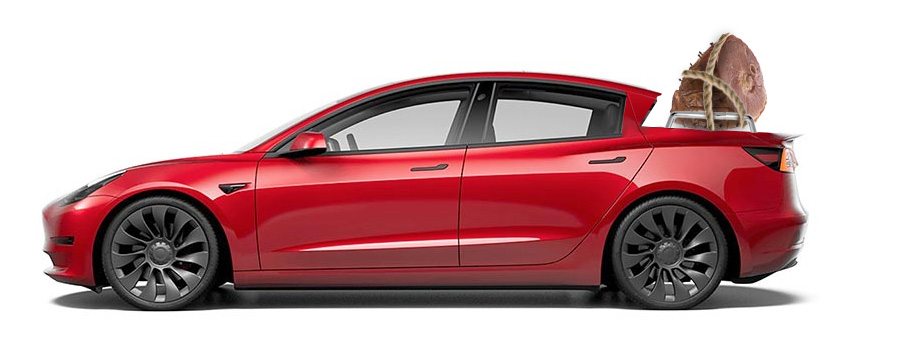You know what’s an automotive styling detail that has never really caught on, but I think deserves another chance? The reverse-raked rear window. That’s the sort of phrase that, for most people, takes a moment to process: reverse…rake…rake means like angle? Reverse is backwards, so a backwards-leaning rear window? Yes. Then you probably would need to remind whomever’s arm you’ve seized, locked eyes with, and are bellowing at that you mean on a car. Very few cars have rear windows that lean backwards, but there have been a few, and, personally, I think there should be more. I think it’s been almost 20 years since a major automaker has sold a car with such a window setup, so let’s just take a moment and refresh ourselves with this little-known and I think under-appreciated stylistic detail.
I think the major examples of the reverse-raked rear window are the following cars, presented chronologically:

I believe there are nine mass-produced cars that utilized a reverse-rake rear window: the ’58 Lincoln Continental, which directly influenced its European Ford siblings, the Anglia and Consul Classic in 1959 and 1961, respectively, ushering in a veritable boom of reverse-rakers in 1961 to 1962, starting with the three-wheel Bond Microcar, then most famously on the Citroën Ami, then over in Japan with the Mazda Carol 360, and then another British three-wheel microcar, the Reliant Regal.
After a four-decade gap, the reverse rake was back, and dramatically so, as the design was a defining characteristic of Toyota’s bold partnership with consumer electronics companies that ended up in 2000’s WiLL Vi. Finally, in 2005, I think we have what may be the most recent iteration of the design, the Citroën C4, though at this point that reverse rake angle is very subtle. Still, I think it still can count, even though it’s also the only hatchback example, as all the other ones have a trunk.
So, why did the designers of these interesting cars decide to use such a peculiar window/C-pillar design? I think there’s a few reasons: first, from a cheapskate standpoint, it’s a way to use a flat or nearly flat piece of rear window glass, which is cheaper than curved, and still have a striking-looking design. In the case of the Lincoln, the flat glass allowed the rear window to open, letting you get a solitary breath of fresh air and let out all the billowing clouds of cigarette smoke, as noted by everyone’s pal, Jay Leno:
Also, as Jay notes there, too, the angle of the window prevented snow and ice buildup in winter, which is handy.
For the smaller cars, a big advantage of the reverse rake is that you get more rear seat headroom without having to go to a hatchback design. Not that there’s anything wrong with hatchbacks, but there are still people that prefer trunks, and the reverse-rake window can make extra rear seat headroom out of thin air and keep that three-box design that so many crave.

What I’m wondering is how this design conceit might translate to modern designs. Let’s take a quick look at two popular modern cars, EVs even, like a Tesla Model 3 and a Ford Mach-E:

Okay, maybe it’s a bit odd at first, but I don’t hate it! I’m sure there’s an aero hit of some sort, so maybe you’ll lose a mile or two of range, but, well, nothing’s free, right? Especially on the Mach-E’s crossover-type design, this look really helps it stand out from all those very similar silhouettes, and in the case of the Tesla, which wan’t a hatchback to begin with, you don’t lose much, and there’s now an opportunity to bring back trunk-lid-mounted luggage racks!

Gotta admit, that’s pretty cool.
There’s just something rakish and daring and bold about these backwards-leaning back windows, and I’d love to see some ballsy automaker give them another go. There’s no easier way to stand out in a Target parking lot, right?




That rear window literally looks like the autopian logo, in some sick, twisted way
You forgot about the slant back Mercurys which lived past the late 50s Continental’s. I drove a 1963 Mercury Monterey “Breezeway” as it was known around 1971. What a bomb. Got pulled over on Sunset Blvd by some nasty Chips because it had outdated tags — the car was borrowed. They made me open the cavernous trunk and unknown to me was a load of living room drapes. Crap, they actually thought there might be a dead body wrapped in that fluffy mass. Anyway, it was nice driving with the “Breezeway” down and keeping the cops well out of sight.
What about the Honda CRX (mk2)? Although the main rear window sloped forward, there was a second window set into the tailgate, which was raked back with the rest of the rear of the car.
The Mercury Breezeways of the 1960s would like a word!